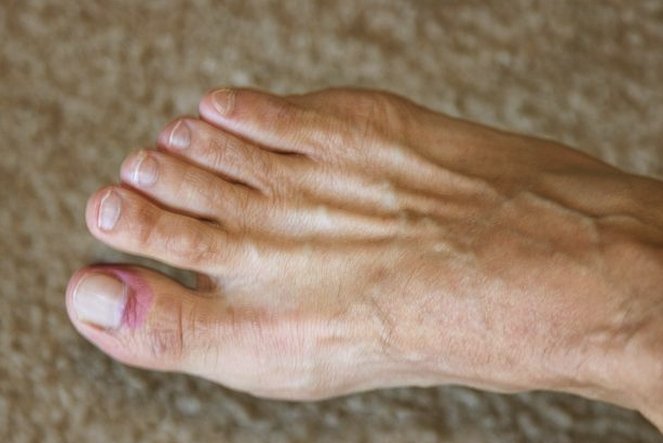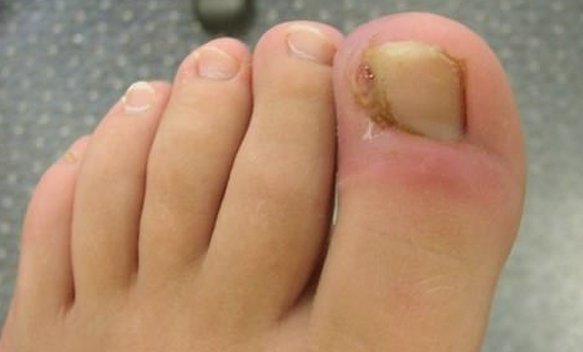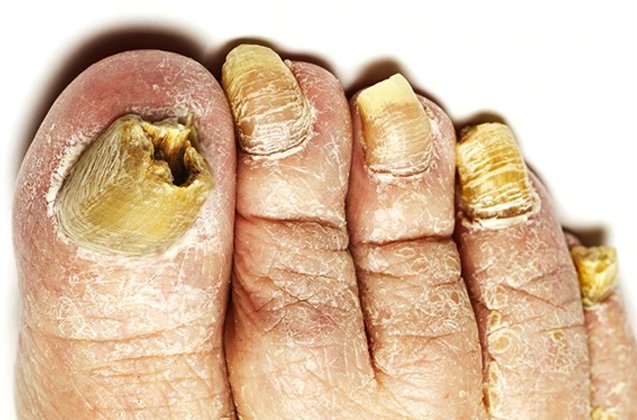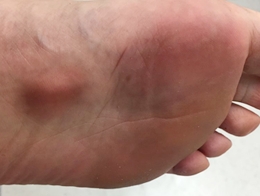Infected Toe

Does your toe hurt when you walk? Take a closer look at your toes. If they are swollen or green in color with thick nails, you may be suffering from an infected toe. Do not panic! In most cases infected toes can be treated using antibiotic medications and you can walk again pain-free.
What are the symptoms of infected toes?
Toe infections come along with some common symptoms such as redness, pain, inflammation and warmth in the infected toes. In some cases, thick or ingrown toenails may be the root of the toe infection. If the infection is due to fungal growth, you may notice that your toenails have turned green in color and is filled with pus.
What causes infection in toes?
Toe infections can be caused due to a variety of reasons such as infections, calluses or underlying medical conditions such as diabetes or peripheral vascular diseases. It is also observed in people with compromised immunity, such as people undergoing chemotherapy. Sometimes, the soft tissues in the feet such as tendons and ligaments may also get infected. Infected toes may be caused due to:
Fungal infections
Infection in your toes may be caused due to fungal infestations (medically known as onychomycosis). Fungal infections take time to aggravate. Therefore, you may not notice any significant changes in the appearance of your toes or nails in the initial stages of fungal infection. At later stages, you may observe a change in color of your nails. Your toenail may turn green or black in color and sometimes you may observe green pus oozing out the nail or blister on the infected toe. Fungal infection occurs in the toe due to excessive growth of fungus under the toenails. Presence of moisture in the toenail, due to the moist environment in your shoes, provides suitable environment for the fungus to grow. Fungal toenail infections are contagious and you may infect your toe if you share your footwear with someone who is already suffering from fungal infection in the toes.
Poor circulation of blood to the lower extremities
Underlying medical conditions such as atherosclerosis or sickle cell anaemia that impede the blood circulation to the lower extremities may cause toe infections. Poor blood flow to the feet may also occur due to the natural process of ageing. Poor blood flow to the foot cause thickening of the toenails and thereby promote fungal growth in the inner layers of the nails, leading to toe infections.
Diabetes
Diabetes is one of the diseases that reduce the blood flow to lower parts of the body. Therefore, people with diabetes are at increased risk of developing toe infections. Moreover, neuropathy occurs as a consequence of uncontrolled blood sugar. Neuropathy may damage your nerves and may lead to decrease in sensation on your foot. If you are a diabetic and you get a cut or blister on your toe due to any reason, it may worsen and may infect your whole foot. Diabetes may also cause cellulitis and deep skin/ soft tissue infections.
Ingrown toenails
Ingrown toenails occur as a result of growing of edges of nail into the skin adjoining the nail. The ingrown nail may cause infection as it pierces into the skin. Ingrown toenails may become a matter of concern if you are diabetic or have some disorder that impedes blood flow into lower extremities. Cutting toenails incorrectly or poor posture while walking or running may cause ingrown toenails. In some cases, genetic predisposition may be the reason for toe infections due to ingrown toenails.
Nail infections
Nail injuries or cuts may be caused due to chemical irritants, carelessness or due to increased pressure on the toes due to ill-fitted shoes. Nail infection (medically referred to as paronychia) occurs when a skin bacteria, mostly staphylococcus, enters the skin around the nail that has been injured. Presence of hangnails may also lead to infection in your toes, causing pain and making your toes look red and swollen. Hangnails are the tiny skin tears that remain when skin splits from the cuticle. Paronychia may also lead to pus formation and may be accompanied by fever and chills, indicating a serious medical condition that requires immediate help from a physician.
In worst cases, infections due to staphylococcus may also spread into the bones of the toes (medically called as osteomyelitis), especially if the person is diabetic.
Can toe infection be treated?
If the infection in your toe is very severe and there is accumulation of pus, you may have to visit a physician to drain the pus out. The physician may use a surgical knife or place a packing called wick to drain the pus out of the infected toe. The wick may be placed for a period of 24- 48 hours to help complete drainage of the pus. You may have to take oral antibiotics after the pus is drained to expedite the healing process.
In extreme cases, partial or complete nail removal may be required to get rid of the infection on the toes. If the infection is incurable and starts spreading to other parts of the feet, the doctor may suggest toe amputation to prevent further damage. Generally toe amputation is the last resort and is recommended only if the infected toe is causing cessation of blood, nutrient and oxygen supply to rest of the foot.
Simple toe infections may be treated by using simple home remedies. You may try the following treatment at home:
Home Remedies
Cold compress
Apply cold compress or ice pack to the affected toe to alleviate the pain and swelling. Do not apply ice cubes directly to the affected skin. Doing so may further damage your tissue and aggravate the pain. Wrap the ice cubes in a wet towel before applying it to your toe.
Warm compress
If your toe infection is caused due to fungal or bacterial growth, it is advisable to use warm compresses. It will help in reducing the fungal or bacterial infection as well as the swelling.
Treatment with warm water
Soak your feet in a tub of warm water for 15- 20 minutes. You may add epsom salt or vinegar to the water. This may be particularly beneficial if you have infected toes due to ingrown nails. You can use an antibacterial soap to thoroughly clean the infected feet. You may apply a topical antibiotic ointment on the infected areas after patting your feet dry with a clean napkin. You should never soak your feet in hot water; the water you are using to soak your feet should be lukewarm.
Treatment with salt water
If you have an infected toe due to injury or fungal infection, you may soak your feet in warm water containing salt. Salt water treatment is particularly beneficial if there is bleeding due to the infection in your toes. The salt acts as a natural antibiotic. Following salt water treatment, you may apply an antibiotic ointment to heal the infection faster. You may wrap your toe after application of ointment in order to prevent the infection from spreading. Alternatively, you may dilute tea tree oil with water and apply it onto the infected toe. Tea tree oil is a natural antibacterial and antioxidant that keeps a check on the growth of the fungus that causes toe infection. It also helps in reducing the inflammation.
Foot elevation
You may keep your infected foot in an elevated position while sitting or sleeping. It is advisable to walk as little as possible till the infection in your toes settle down. Bear in mind that walking on your toes can delay healing.
Choosing the right footwear
If you have any form of toe infection, it is advisable to wear loose fitting shoes, so as to avoid worsening of the problem. It is advisable to wear socks that absorb sweat and minimize moisture.
Take care of the infected toe
- If there is pus accumulation in the infected toe, do not try to drain it out yourself. It may cause bleeding, spreading of infection and delay in the healing procedure.
- Avoid applying nail polish or rubbing coal on your infected toenail. In general you should apply only antifungal ointments or bandages on your infected toes.
- If the infection and pain in your toes persist for more than a week even after trying these home remedies, you should visit your physician to decide the right course of treatment for you.
Prevention of Toe Infections
- Toe infections can be prevented by taking proper care of your foot. If you are a diabetic, take care not to injure your toes while running or walking. If you notice a small cut or blister on your toe or any part of your feet that persists for more than a week, it is advisable to consult a physician.
- Avoid going barefoot to public places, especially public bathrooms.
- Avoid sharing your shoes or footwear with others.
- Avoid digging under or cutting your ingrown toenails on your own; you may end up infecting your toe and worsening the pain. Visit a podiatrist to prop up your ingrown toenail or to cut it.
- If you have a hangnail, do not try to pull it out forcefully. Soak your toes in warm water to soften your skin and nails and then carefully cut the hangnails using a nail clipper. Apply moisturizing oil once you have clipped your hangnail.
- If you get a pedicure done at a salon, make sure that the tools being used are appropriately sterilized. Tools such as nail clippers can be a potential source of toe infection if not appropriately sterilized.
- Maintain proper foot hygiene at all times. Do not keep your feet moist for a long time.








